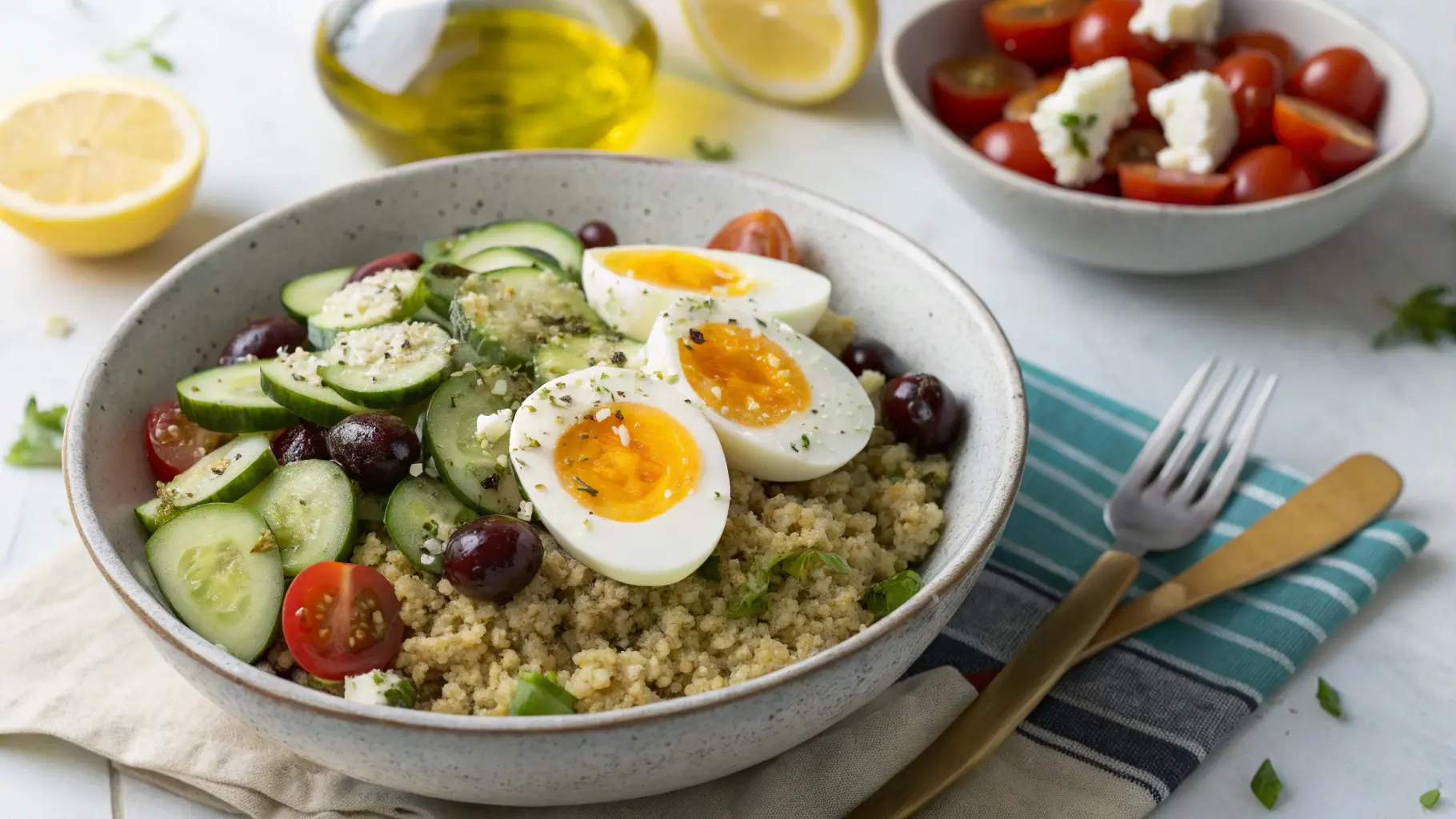Eggs are one of nature’s most versatile and nutrient-packed foods. Whether you’re cooking up breakfast, lunch, or dinner, eggs can easily fit into a healthy diet. They are rich in protein, vitamins, and minerals, offering a satisfying and affordable way to fuel your body. In this guide, we’ll explore the healthiest ways to prepare eggs, share easy and creative recipes, and uncover tips to maximize their nutritional value. By the end of this article, you’ll be inspired to incorporate eggs into your meals with confidence and creativity.
Table of Contents

What Are the Healthiest Ways to Eat an Egg?
Eggs are highly nutritious, but the way you cook them can make all the difference. Cooking methods like boiling, poaching, and baking are considered the healthiest, as they preserve nutrients and minimize added fats.
Why Boiled Eggs Are a Top Choice
Boiling eggs is a simple yet effective way to retain their nutritional value. The method involves placing eggs in hot water until the whites and yolks are fully set. Boiled eggs are an excellent source of lean protein and can be enjoyed on their own, sliced into salads, or paired with whole grain toast for a balanced snack. Because no oils or butter are required, boiled eggs are naturally low in calories.
- Pro Tip: For perfectly boiled eggs, place them in cold water, bring them to a boil, and then simmer for 7-9 minutes. Immediately transfer them to an ice bath to make peeling easier.
The Gentle Art of Poaching
Poached eggs offer a velvety texture and rich taste without the need for added fats. The key to poaching is creating a vortex in gently simmering water and cracking the egg into the center. This method preserves the creamy yolk, which contains heart-healthy fats, vitamin D, and choline, a nutrient essential for brain health.
- Actionable Tip: Add a splash of vinegar to the water to help the egg whites hold their shape while poaching.
Why Baking Is Underrated
Baking eggs is a lesser-known but equally healthy method. For instance, baked egg cups or casseroles allow you to combine eggs with vegetables, herbs, and even lean meats. This method not only creates a flavorful dish but also makes it easier to prepare meals in bulk for meal prep.
Looking for more ways to simplify your meals? Explore these quick and healthy breakfast recipes.
What Is the Healthiest Thing to Cook Eggs In?
The cookware and cooking oils you use can have a significant impact on the healthfulness of your egg dishes. Choosing the right tools and fats ensures that you maximize nutrients while avoiding unhealthy additives.
Healthy Cookware Choices
Non-stick pans and ceramic cookware are ideal for cooking eggs because they require little to no oil. This reduces the amount of fat and calories in your meal while ensuring even cooking. Silicone bakeware is another excellent option for baked egg recipes, offering easy cleanup and consistent results.
- Example: If you’re making scrambled eggs, a non-stick pan will allow you to achieve a soft, fluffy texture with just a teaspoon of oil or butter.
Best Oils for Cooking Eggs
When it comes to cooking fats, the healthiest options are olive oil, avocado oil, and coconut oil. These oils are rich in unsaturated fats, which are good for heart health. Olive oil, in particular, has been shown to reduce inflammation and support overall well-being. However, it’s essential to use these oils sparingly to avoid unnecessary calories.
- Practical Advice: For a flavor twist, try sautéing your vegetables in avocado oil before adding whisked eggs. This creates a nutrient-dense, flavorful dish that pairs well with whole grain toast.
How Can I Make My Eggs Healthier?
Eggs are already a nutritional powerhouse, but there are simple ways to make them even healthier. By adding nutrient-rich ingredients and reducing less healthy ones, you can elevate the nutritional profile of your meal.
Add Vegetables for a Nutritional Boost
Incorporating vegetables into your egg dishes is one of the easiest ways to add vitamins, minerals, and fiber to your meal. Spinach, bell peppers, mushrooms, and tomatoes are excellent choices. Not only do they enhance flavor, but they also provide essential nutrients like vitamin C, potassium, and antioxidants.
- Example: Try a spinach and mushroom omelette topped with diced tomatoes for a low-calorie, high-fiber breakfast. This combination supports digestion and helps you stay full for longer.
Use Healthy Add-Ins
Instead of heavy cream or full-fat cheese, opt for Greek yogurt or low-fat cheese. Greek yogurt adds creaminess to scrambled eggs while reducing fat and calorie content. Additionally, flaxseeds or chia seeds can be whisked into the eggs before cooking to increase omega-3 fatty acids and fiber.
- Pro Tip: Add a pinch of turmeric and black pepper to scrambled eggs for anti-inflammatory benefits and a vibrant golden color.
Limit Processed Ingredients
Many traditional egg dishes include processed meats like bacon or sausage. Instead, opt for lean protein sources such as turkey sausage, smoked salmon, or even plant-based alternatives. This swap lowers saturated fat and sodium levels while keeping your meal protein-packed.
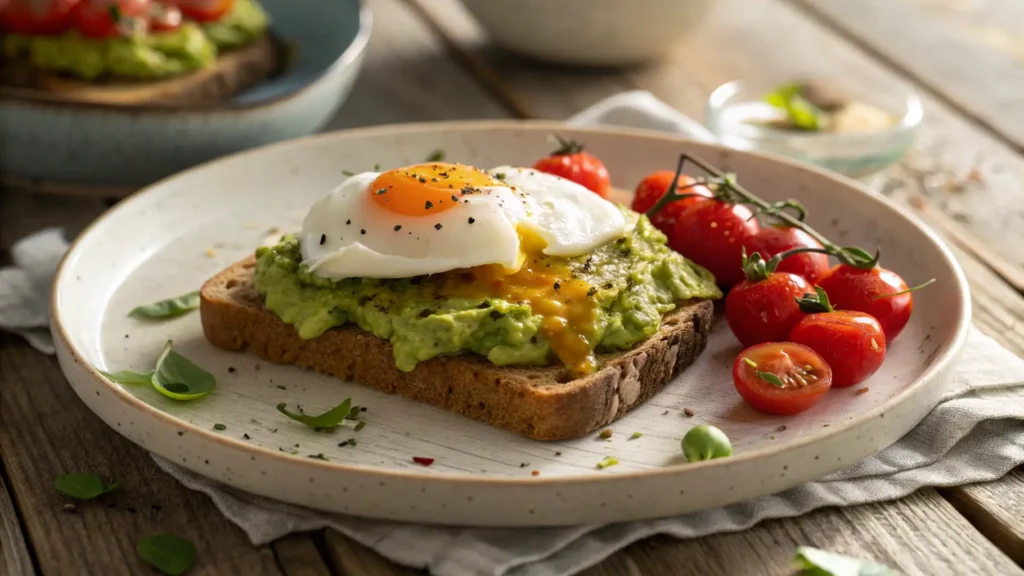
Is It Healthy to Eat 5 Eggs a Day?
The answer to whether eating five eggs a day is healthy depends on your overall diet and individual health. While eggs are a fantastic source of protein and nutrients, moderation is key.
Understanding Cholesterol and Egg Consumption
Eggs are high in dietary cholesterol, with one large egg containing about 186 milligrams. However, research has shown that for most healthy individuals, dietary cholesterol has little impact on blood cholesterol levels. The body regulates cholesterol production based on dietary intake, making eggs a safe option for many.
- Scientific Insight: According to the American Heart Association, consuming up to one egg per day is safe for most people. Those with high cholesterol or heart disease should consult their doctor to determine a safe intake.
Balancing Your Diet
If you’re eating five eggs a day, it’s crucial to balance them with other protein sources such as beans, lentils, fish, or chicken. Incorporating a variety of protein sources ensures that you’re meeting your nutrient needs without over-relying on one food.
- Practical Tip: Consider enjoying eggs as part of a mixed dish, like a vegetable frittata or a grain bowl, to diversify your nutrient intake and keep meals exciting.
For more guidance on creating balanced meals, check out our tips for building healthy dinner plates.
Easy & Healthy Egg Recipe Ideas to Try Today
Eggs are an incredibly versatile ingredient, lending themselves to a variety of recipes that can be customized to fit your taste and dietary needs. Below are a few easy and healthy ideas to inspire your next meal.
Recipe 1: Veggie-Packed Frittata
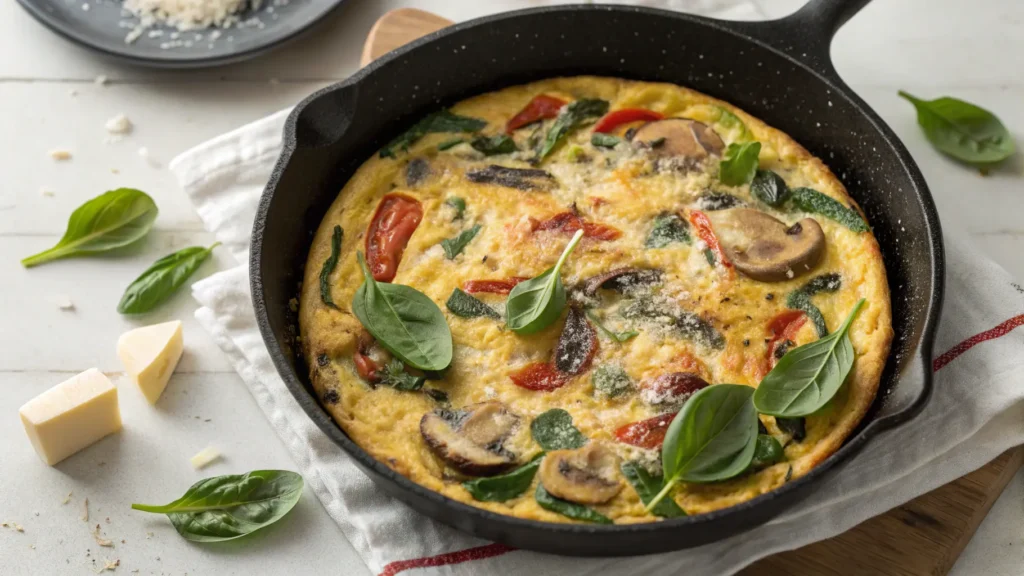
This veggie-filled frittata is the perfect way to use up leftover produce while creating a nutrient-dense dish. It’s great for meal prepping and works equally well for breakfast, lunch, or dinner.
Ingredients:
| Ingredient | Amount | Notes |
|---|---|---|
| Eggs | 6 large | Organic or free-range preferred |
| Spinach | 1 cup | Fresh or frozen |
| Bell peppers | 1 cup | Chopped |
| Mushrooms | 1 cup | Sliced |
| Olive oil | 1 tbsp | For greasing the skillet |
| Low-fat cheese (optional) | 1/2 cup | Shredded |
| Salt and pepper | To taste | Adjust to preference |
Instructions:
- Preheat your oven to 375°F (190°C).
- Heat olive oil in an oven-safe skillet over medium heat. Add spinach, bell peppers, and mushrooms, and sauté until softened, about 5 minutes.
- Whisk the eggs with salt, pepper, and cheese if using. Pour the egg mixture into the skillet, stirring gently to combine with the vegetables.
- Transfer the skillet to the oven and bake for 12-15 minutes, or until the eggs are fully set.
- Allow the frittata to cool slightly before slicing into wedges and serving.
How to Make Healthy Egg Recipes Step-by-Step
Building on the versatile recipes shared earlier, let’s dive deeper into how you can transform eggs into delicious meals with easy, step-by-step instructions. By following these tips and techniques, you’ll be able to create dishes that are not only healthy but also flavorful and satisfying.
Recipe 2: Healthy Breakfast Egg Muffins
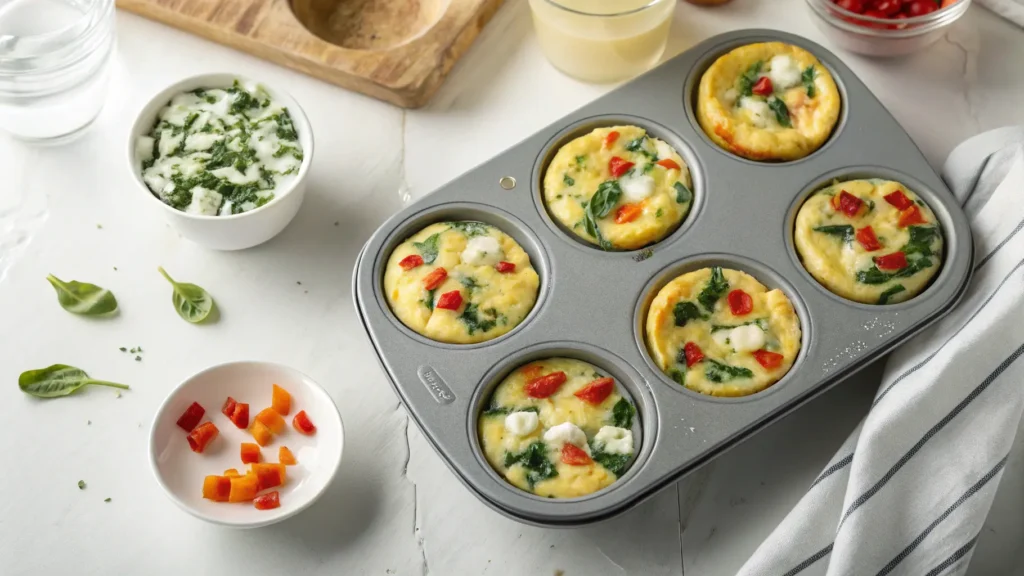
Egg muffins are an excellent option for meal prep, as they can be made in advance and enjoyed throughout the week. They’re packed with protein, vegetables, and flavor, making them perfect for a grab-and-go breakfast or snack.
Ingredients:
| Ingredient | Amount | Notes |
|---|---|---|
| Eggs | 8 large | Whisked |
| Bell peppers | 1 cup | Chopped finely |
| Spinach | 1 cup | Fresh or frozen (thawed) |
| Low-fat cheese | 1/2 cup | Shredded |
| Olive oil | 1 tbsp | For greasing the muffin tin |
| Salt and pepper | To taste | Adjust to preference |
Instructions:
- Preheat your oven to 350°F (175°C).
- Grease a muffin tin with olive oil to prevent sticking.
- In a large mixing bowl, whisk together the eggs, salt, and pepper.
- Divide the chopped vegetables evenly among the muffin tin cups.
- Pour the whisked eggs over the vegetables, filling each cup about three-quarters full.
- Sprinkle a small amount of shredded cheese on top of each cup for added flavor.
- Bake in the preheated oven for 18-20 minutes, or until the eggs are fully set and golden.
- Let the muffins cool slightly before removing them from the tin. Serve warm or store in the fridge for up to five days.
Egg muffins are incredibly versatile—you can swap out the vegetables for whatever you have on hand, such as zucchini, mushrooms, or cherry tomatoes.
Recipe 3: Mediterranean-Inspired Egg Bowl
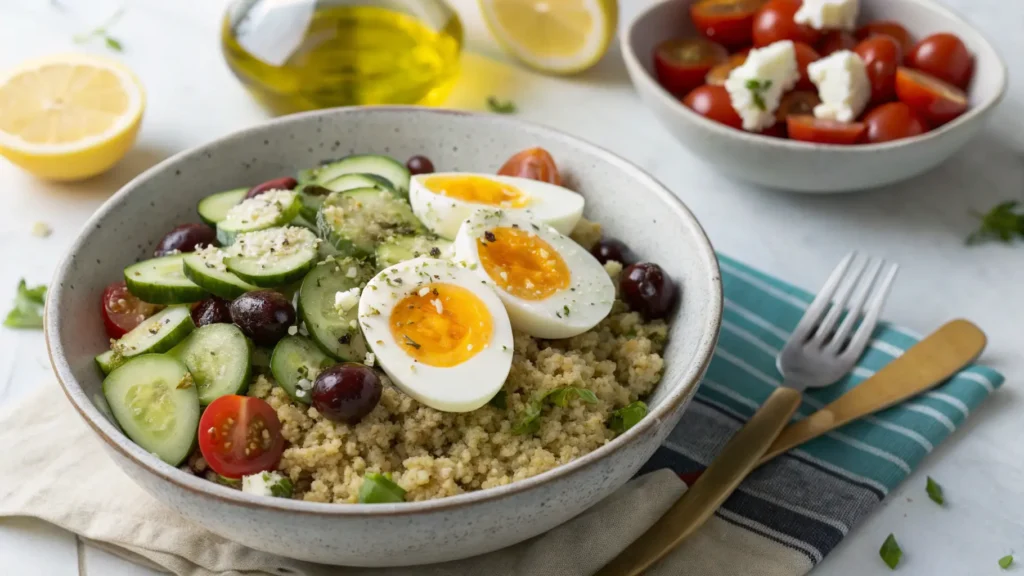
For a fresh and vibrant dish, try a Mediterranean-inspired egg bowl. This recipe combines soft-boiled eggs with quinoa, fresh vegetables, and a tangy lemon dressing for a balanced and satisfying meal.
Ingredients:
| Ingredient | Amount | Notes |
|---|---|---|
| Eggs | 2 large | Soft-boiled |
| Quinoa | 1/2 cup | Cooked |
| Cucumber | 1/2 cup | Diced |
| Cherry tomatoes | 1/2 cup | Halved |
| Kalamata olives | 1/4 cup | Pitted |
| Feta cheese | 1/4 cup | Crumbled |
| Olive oil | 1 tbsp | For the dressing |
| Lemon juice | 1 tbsp | Freshly squeezed |
| Salt and pepper | To taste | Adjust to preference |
Instructions:
- Start by soft-boiling the eggs. Place them in a pot of simmering water and cook for 6-7 minutes. Transfer them to an ice bath to stop the cooking process.
- In a medium bowl, combine cooked quinoa, cucumber, cherry tomatoes, and Kalamata olives.
- Drizzle olive oil and lemon juice over the mixture, then season with salt and pepper. Toss to combine.
- Slice the soft-boiled eggs in half and arrange them on top of the quinoa mixture.
- Sprinkle with crumbled feta cheese and serve immediately.
This recipe is perfect for lunch or dinner and can be customized with additional toppings like avocado or roasted chickpeas for added texture and flavor.
Pro Tips & Variations
Elevate your egg dishes with these expert tips and creative variations to keep your meals exciting and nutrient-dense.
Pro Tips for Cooking Eggs
- Use Room Temperature Eggs: Allowing eggs to come to room temperature before cooking helps them cook more evenly and prevents the whites from becoming rubbery.
- Low and Slow: When scrambling eggs, cook them over low heat and stir continuously for a creamy, custard-like texture.
- Season at the Right Time: Add salt to eggs just before cooking to avoid breaking down their structure, which can lead to watery results.
Creative Variations to Try
- Mexican-Inspired Scramble: Add diced jalapeños, black beans, and a sprinkle of cumin to your scrambled eggs. Top with fresh salsa and avocado for a flavorful twist.
- Asian-Style Omelette: Whisk soy sauce and sesame oil into your eggs, then fill your omelette with sautéed mushrooms and scallions. Drizzle with sriracha for a spicy kick.
- Sweet and Savory Breakfast Bowl: Pair scrambled eggs with roasted sweet potatoes, arugula, and a dollop of almond butter for a unique and satisfying combination.
How to Make Healthy Egg Recipes Step-by-Step
Expanding on the healthy recipes shared earlier, this section provides additional techniques and recipes that highlight eggs’ versatility. From protein-packed snacks to full meals, these dishes are easy to prepare and packed with nutrients. Let’s dive deeper into creative ways to enjoy eggs as a staple of your healthy diet.
Recipe 4: Veggie-Loaded Egg Stir-Fry
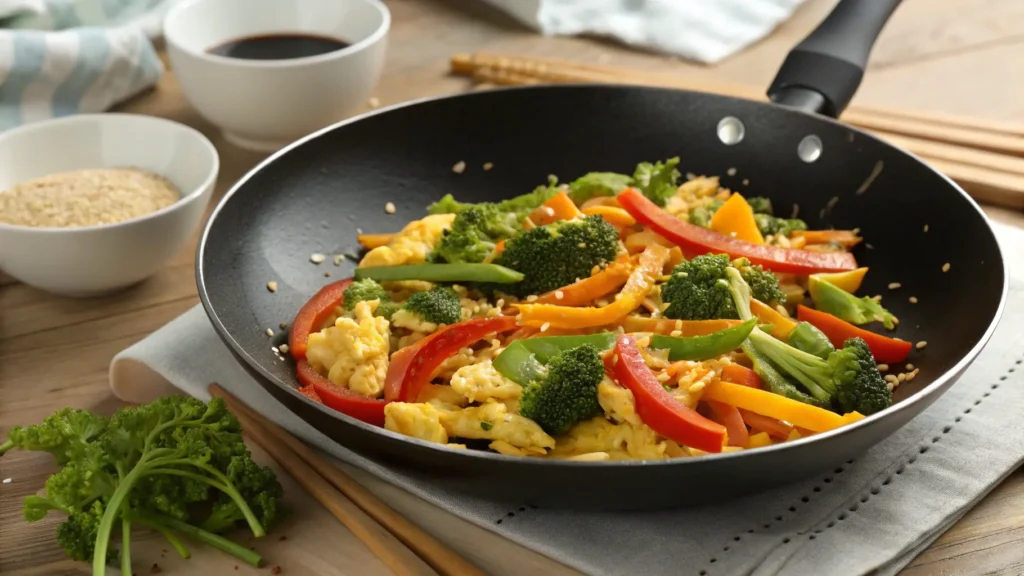
For a quick, nutrient-rich meal, an egg stir-fry is the perfect choice. Combining protein-packed eggs with colorful vegetables and aromatic seasonings makes for a wholesome dish that’s both satisfying and flavorful.
Ingredients:
| Ingredient | Amount | Notes |
|---|---|---|
| Eggs | 3 large | Whisked |
| Broccoli florets | 1 cup | Steamed or lightly cooked |
| Bell peppers | 1 cup | Sliced into thin strips |
| Carrots | 1/2 cup | Julienned |
| Garlic | 2 cloves | Minced |
| Soy sauce | 2 tbsp | Low-sodium recommended |
| Olive oil | 1 tbsp | For cooking |
| Sesame seeds | 1 tsp | Optional garnish |
| Salt and pepper | To taste | Adjust as needed |
Instructions:
- Heat olive oil in a large skillet or wok over medium heat. Add the minced garlic and sauté until fragrant, about 1 minute.
- Add the broccoli, bell peppers, and carrots to the skillet. Stir-fry the vegetables for 3-4 minutes until they begin to soften.
- Push the vegetables to one side of the skillet and pour the whisked eggs into the empty space. Stir continuously as the eggs cook and scramble.
- Once the eggs are set, mix them with the vegetables and add the soy sauce. Stir everything together for another 1-2 minutes.
- Sprinkle with sesame seeds for garnish and serve warm.
This recipe is highly customizable—feel free to add mushrooms, snap peas, or zucchini for even more variety.
Recipe 5: Classic Deviled Eggs with a Healthy Twist
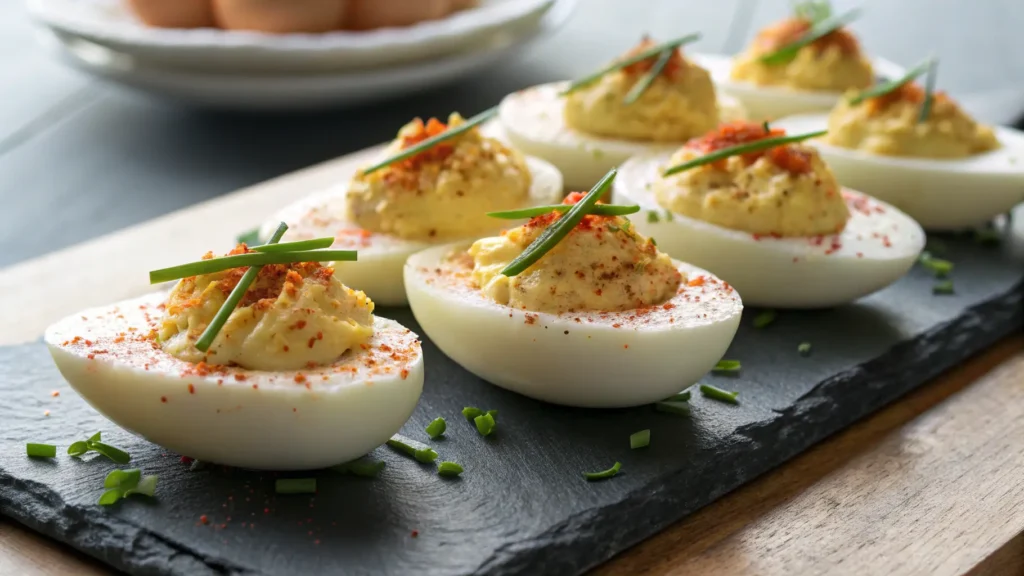
Deviled eggs are a timeless classic, but they often rely on heavy mayonnaise. This lighter version uses Greek yogurt for creaminess without the added fat, making it a healthier snack or appetizer option.
Ingredients:
| Ingredient | Amount | Notes |
|---|---|---|
| Eggs | 6 large | Hard-boiled |
| Greek yogurt | 1/4 cup | Plain, unsweetened |
| Dijon mustard | 1 tsp | Adds tanginess |
| Lemon juice | 1 tsp | Freshly squeezed preferred |
| Smoked paprika | 1/2 tsp | Optional garnish |
| Salt and pepper | To taste | Adjust as needed |
Instructions:
- Slice the hard-boiled eggs in half lengthwise and carefully remove the yolks. Place the yolks in a small mixing bowl.
- Mash the yolks with a fork, then mix in Greek yogurt, Dijon mustard, and lemon juice. Stir until smooth and creamy.
- Spoon or pipe the yolk mixture back into the egg white halves.
- Sprinkle with smoked paprika for a finishing touch. Chill in the refrigerator for 15-20 minutes before serving.
These deviled eggs are perfect for parties, meal prep, or as a quick protein-packed snack between meals.
Pro Tips & Variations
To ensure your egg dishes are as delicious as they are nutritious, follow these expert tips and experiment with creative variations. These ideas will help you get the most out of your ingredients while keeping meals exciting and healthy.
Essential Tips for Cooking Eggs
- Avoid Overcooking: Overcooked eggs can become rubbery and lose some of their nutritional value. Watch your cooking times closely to ensure tender results.
- Invest in Quality Ingredients: Opt for free-range or organic eggs, which often have higher nutrient levels and richer flavor.
- Experiment with Seasonings: Eggs are a blank canvas for flavor. Use fresh herbs, garlic powder, or spice blends like za’atar or Cajun seasoning to add depth to your dishes.
Creative Ways to Customize Your Recipes
- Add Grains: Pair your eggs with cooked quinoa, brown rice, or farro for a heartier meal that balances protein and carbs.
- Try International Flavors: Add curry powder to scrambled eggs for an Indian-inspired dish, or mix soy sauce and green onions into your eggs for a Japanese twist.
- Make It Sweet: For a unique breakfast option, whisk eggs with a splash of vanilla extract and cinnamon. Serve them scrambled alongside fresh fruit and a drizzle of honey.
FAQs: Your Healthy Egg Recipe Questions Answered
What Is the Healthiest Way to Eat an Egg?
The healthiest ways to prepare eggs are boiling, poaching, and baking, as these methods avoid added fats while retaining the egg’s nutrients. Boiled eggs are ideal for snacks, poached eggs pair well with salads, and baked eggs are perfect for frittatas or casseroles.
What Is the Healthiest Thing to Cook Eggs In?
Cooking eggs in heart-healthy oils like olive oil or avocado oil enhances their flavor while providing beneficial fats. Non-stick pans or silicone bakeware are excellent tools for minimizing the need for added oils.
What Can I Add to My Eggs to Make Them Healthier?
Adding vegetables such as spinach, mushrooms, and tomatoes boosts the nutritional content of your egg dishes. You can also mix in omega-3-rich seeds like flaxseeds or chia seeds. For a flavor boost, try fresh herbs, garlic, or turmeric.
Is It Healthy to Eat 5 Eggs a Day?
For most people, eating 1-2 eggs per day is a healthy balance. While eggs are rich in protein and nutrients, consuming five eggs daily may be excessive, especially for individuals with heart conditions or high cholesterol. Consult a healthcare professional for personalized guidance.
Are There Vegan Alternatives to Eggs?
Yes, plant-based alternatives like tofu, chickpea flour, and flax eggs are excellent for those avoiding animal products. These substitutes can be used in scrambles, quiches, and baked goods, offering similar textures and flavors.
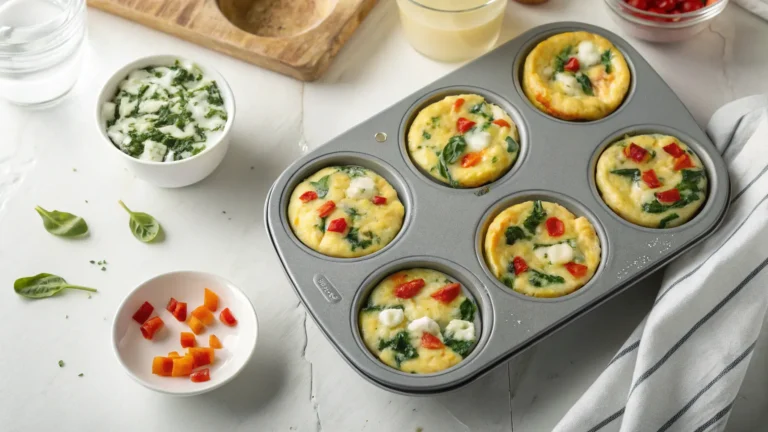
Healthy Breakfast Egg Muffins
- Total Time: 30 m
- Yield: 12 1x
Ingredients
- 8 large eggs (whisked)
- 1 cup bell peppers (chopped finely)
- 1 cup spinach (fresh or frozen, thawed and drained)
- 1/2 cup low-fat cheese (shredded)
- 1 tablespoon olive oil (for greasing the muffin tin)
- Salt and pepper (to taste)
Instructions
- Preheat your oven to 350°F (175°C).
- Grease a muffin tin with olive oil to prevent sticking.
- In a large mixing bowl, whisk together the eggs, salt, and pepper.
- Divide the chopped bell peppers and spinach evenly among the muffin tin cups.
- Pour the whisked eggs over the vegetables, filling each cup about three-quarters full.
- Sprinkle a small amount of shredded cheese on top of each cup for added flavor.
- Bake in the preheated oven for 18-20 minutes, or until the eggs are fully set and slightly golden.
- Let the muffins cool slightly before removing them from the tin. Serve warm or store in the refrigerator for up to five days.
Notes
Pros
- Easy to meal prep for busy mornings.
- High in protein and low in carbs.
- Customizable with various vegetables and add-ins.
- Great for grab-and-go breakfasts or snacks.
Cons
- May require reheating for best flavor.
- Some ingredients may release moisture if not properly prepared (e.g., frozen spinach).
- Prep Time: 10 m
- Cook Time: 20 m
- Category: Breakfast
- Cuisine: American
Nutrition
- Calories: 120
Keywords: healthy, breakfast, egg muffins, protein-rich, low-carb, meal prep, easy recipe, high-protein
Conclusion
Eggs are an incredibly versatile and nutritious ingredient that can be used to create a wide variety of healthy dishes. By experimenting with different cooking methods, flavors, and add-ins, you can enjoy eggs in ways that suit your dietary preferences and health goals. From protein-packed stir-fries to creative twists on classic recipes, the possibilities are endless. Start incorporating these healthy egg recipes into your meals and take your nutrition to the next level!

